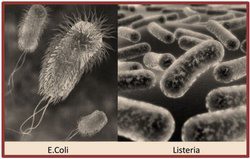 Scientists from Spain and The Netherlands have evaluated the native microorganisms from fresh and fresh-cut fruit that showed an inhibitory activity against the most important bacterial pathogens (Escherichia coli O157:H7, Salmonella, Listeria innocua) detected on the fresh produce up to the present.
Scientists from Spain and The Netherlands have evaluated the native microorganisms from fresh and fresh-cut fruit that showed an inhibitory activity against the most important bacterial pathogens (Escherichia coli O157:H7, Salmonella, Listeria innocua) detected on the fresh produce up to the present.The study was carried out on fresh-cut apples and peaches, 97 and 107 strains were isolated from apples and peaches, respectively. The best antagonist was tested for phytopathogenicity, antimicrobial substances production, and minimum inhibitory concentration.
Among isolated microorganisms, only 7 strains were selected for their strong antagonistic activity with more than 1-log unit reduction of bacterial pathogen load. However, the CPA-7 strain, identified as Pseudomonas graminis, resulted the best antagonist by reducing the bacterial pathogen load from 2.8 to 5.9-log units. Moreover, it resulted the only able to inhibit Escherichia coli O157:H7 at refrigeration temperatures on both fruits.
Tabels - Population of Escherichia coli O157:H7 on 'Golden Delicious' apple (left) and'Elegant Lady' peach (right), plugs in the presence of different antagonists(concentration between 10 6 e 10 8 cfu/ml) and stored at 5 °C over 10 days. Plugs were inoculated with con E. coli O157:H7 at 10 7 cfu/ml. . Click here to enlarge the tables.

This study has showed that Pseudomonas graminis could be used as biological control against the potential bacterial pathogens of fresh-cut fruit. However, its antagonistic activity against pathogens is not instantaneous but it occurs gradually during shelf-life, thus the scientists suggest to use the antagonist only after other sanitation treatments.
Source: Alegre I., Viñas I., Usall J., Teixidó N., Figge M.J., Abadias M., "Control of foodborne pathogens on fresh-cut fruit by a novel strain of Pseudomonas graminis", 2013, Food Microbiology, Vol. 34, pagg. 390-399. Further info: http://www.ncbi.nlm.nih.gov/pubmed/23541207








